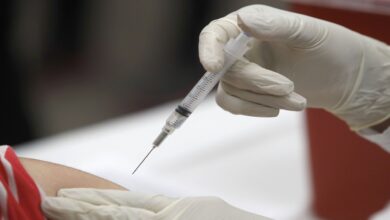What Is CoolSculpting? Experts Explain PAH Risk and Other Potential Side Effects

- Fashion and beauty icon Linda Evangelista, 56, took to social media to share that she’s experiencing side effects after turning to CoolSculpting, a topical procedure that freezes fat cells.
- A rare side effect called paradoxical adipose hyperplasia can occur in the weeks and months after fat-melting procedures, where fat cells become enlarged and harden.
- This side effect, as well as others that patients are warned about prior to CoolSculpting, may require surgery to correct.
The hype around fat-melting cosmetic procedures may dip after Linda Evangelista, the supermodel known for her work with Versace in the ’90s and time as a Revlon brand ambassador, revealed she’s undergone painful corrective surgeries after turning to CoolSculpting. Evangelista, 56, took to social media to share that she’s experienced traumatic side effects after turning to the non-invasive cosmetic procedure — classified by scientists as cryolipolysis, and often turned to by celebrities at large — that’s intended to topically reduce body fat over a series of treatments. The bombshell revelation indicated that Evangelista ended up experiencing fat growth on certain areas of her body rather than the slimming effect she was hoping for.
This content is imported from Instagram. You may be able to find the same content in another format, or you may be able to find more information, at their web site.
“To my followers who have wondered why I have not been working while my peers’ careers have been thriving, the reason is that I was brutally disfigured by Zeltiq’s CoolSculpting procedure which did the opposite of what it promised,” she revealed via Instagram. “It increased, not decreased, my fat cells and left me permanently deformed even after undergoing two painful, unsuccessful corrective surgeries. I have been left, as the media has described, ‘unrecognizable’.”
Fat-targeting procedures like CoolSculpting are normally considered an unobtrusive alternative to procedures like liposuction. But there are a few minor side effects to consider, as well as a rarer risk that Evangelista indicated had impacted her own fat cells.
The fashion icon developed what’s known to experts as paradoxical adipose hyperplasia or PAH — something that doctors and care providers have always had to contend with warning patients about prior to CoolSculpting procedures. The condition (which is also colloquially referred to as the “stick of butter” effect by some) prompts fat tissue in the impacted area to grow larger and, often, harden permanently. This seems to be the case for Evangelista, who alleges that she wasn’t educated about the potential risk before signing up for CoolSculpting.
What other kinds of potential side effects do patients face prior to this procedure, and what exactly causes PAH in the first place?
Weight loss, health and body image are complex subjects — we invite you to gain a broader perspective by reading our exploration into the hazards of diet culture.
What Is CoolSculpting?
To understand how an individual may end up with a hard mass of fat beneath their skin, you’ll need to get familiar with the procedure first, which makes use of a long, thin CoolSculpting applicator that is positioned topically on areas of the patients’ choice.
“Fat is sucked into a suction-cup-like handpiece, and this area of fat in the handpiece is exposed to very low temperatures which, in essence, freeze the fat cells and cause them to crystalize,” says Troy Pittman, M.D., a board-certified aesthetic plastic surgeon in private practice in Washington, D.C. “The frozen fat cells then die — a process called cellular apoptosis — and then the immune system clears away the cellular debris.”
This chilly approach to targeting fat deposits on the body is relatively new — CoolSculpting, in particular, was first approved by officials at the Food and Drug Administration (FDA) in 2010. But the key distinction that has people often signing up for multiple sessions of CoolSculpting over many years is the fact that it’s designed to eliminate targeted areas of body fat. It is not a holistic weight loss procedure like gastric bypass, for example; CoolSculpting is intended to treat areas of fat that can’t be addressed through diet, exercise or lifestyle changes, as indicated by its promotional website.
Current recommendations indicate that CoolSculpting can be applied to areas including thighs, arms, the stomach area, the buttocks and regions of your face, particularly the chin. The procedure itself takes just a few hours at most, but patients see direct results within six months, with some research-based reports indicating that a single session can reduce up to 20% of composite fat in the implicated area. While some patients treat the same area repeatedly for better results, pricing for a single session can cost up to $4,000.
According to Dr. Pittman, the risks that CoolSculpting patients are briefed on before their first procedure includes:
- A feeling of pulling or tugging on the skin at the treatment site, which may include pain
- Redness, bruising, and other skin sensitivity or swelling after the procedure, potentially up to a week afterward
- Those who target their chins may feel sensations in their throat in the days following their procedures
- More rarely, development of PAH within a few months after the procedure
What is PAH and how is it developed?
This side effect is indeed considered rare by most experts, including Dr. Pittman, and has been previously illustrated to affect less than 1% of those who turn to fat-melting cooling procedures, according to JAMA Dermatology. Plastic surgeons don’t usually catch PAH until well after the procedure, as Dr. Pittman explains that growth of fat cells occurs slowly over time, and they are still unaware of what causes it in the first place.
Nearly everyone who has experienced PAH share that the affected area may be painful or sore to touch. “This leaves patients with a treatment area that gets fatter rather than skinnier,” he adds.
It may be that PAH is more common with larger CoolSculpting applicators and older devices, but Dr. Pittman adds that the side effect is more often noted in men than in women. “It seems to appear more frequently in the lower abdomen than on other parts of the body,” he says. “There’s no way to predict which patients will suffer from PAH, so all patients should be warned.”
While there aren’t significant long-term health risks associated with PAH, individuals will have to turn to a potentially painful surgical procedure to treat it — something that CoolSculpting patients usually wanted to avoid in the first place. Dr. Pittman says most commonly, the hardened mass of fat is removed using liposuction (which isn’t guaranteed to relieve it entirely) or patients are placed into surgery to extract it outright.
Is there an alternative to CoolSculpting?
If hearing about Evangelista’s case has you thinking about these procedures overall, many plastic surgeons may indicate that CoolSculpting isn’t always the best route for topical fat reduction, despite more than eight million individuals signing up for the procedure, according to the New York Times.
“The gold standard for fat reduction is surgical liposuction,” Dr. Pittman tells us. “For patients that are looking for a non-surgical treatment with minimal to no downtime, their expectations should be managed appropriately; they’re not going to get a surgical result from a non-surgical treatment.”
There are also other topical alternatives to CoolSculpting specifically, including TruSculptID, which is licensed to doctors by Cutera. This treatment harnesses a “radio-based frequency energy” to target fat cells by heating them, rather than freezing them, Dr. Pittman explains, adding that the procedure maintains a similar result. Like CoolSculpting, best results may come after multiple treatments.
It’s crucial that you consult your primary health care provider before seriously considering any form of plastic surgery, as your individual medical history may make certain procedures riskier for your health. This article is meant to be educational in nature and isn’t a substitute for actual medical or treatment advice from a licensed professional.
This content is created and maintained by a third party, and imported onto this page to help users provide their email addresses. You may be able to find more information about this and similar content at piano.io




